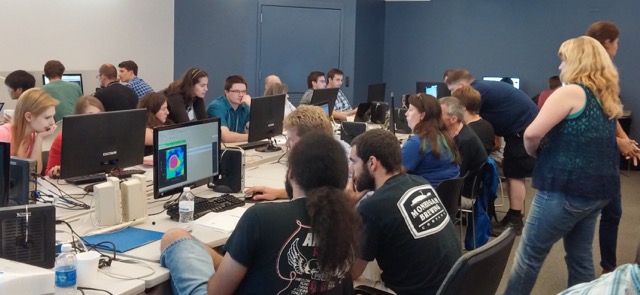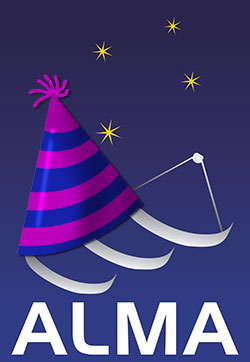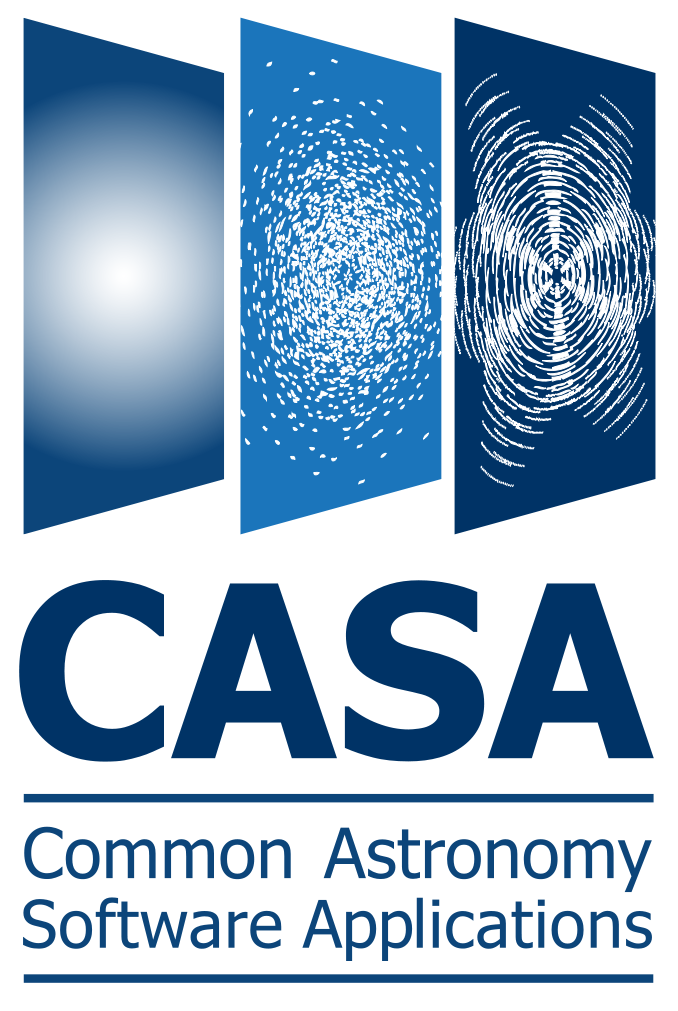NRAO eNews
Volume 8, Issue 9
10 November 2015
NRAO eNews
Volume 8, Issue 9 • 10 November 2015

Next Generation VLA Workshop at the January AAS meeting
4 January 2016
AAS Meeting Venue: Gaylord Palms Convention Center, Sun B
The NRAO is organizing a one-day workshop on Monday, 4 January 2016 – immediately prior to the American Astronomical Society meeting in Kissimmee, Florida – to discuss the scientific motivation and technical concept for a next generation Very Large Array (ngVLA).
This Workshop will update the community on progress toward the ngVLA concept and foster broad discussion of the science case and technical challenges. The program includes:
- Invited presentations of current scientific drivers for the ngVLA;
- Contributed science talks that expand the ngVLA science case;
- Discussion of the technical requirements and challenges emerging from the science program;
- Discussion of ngVLA synergies with other science facilities, such as the Atacama Large Millimeter/submillimeter Array, James Webb Space Telescope, High Definition Space Telescope, Square Kilometre Array, and Thirty Meter Telescope.
Please visit the ngVLA Workshop 2016 website for additional information: five wide-ranging science white papers are available in the ngVLA memo series and on arXiv. An ngVLA web discussion forum has been initiated, and the detailed program is nearing completion. The abstract submission deadline is 20 November.
We request attendees register at the Workshop website so that we can adequately plan for seating and refreshments. Registration is free and is not required to attend.
We look forward to seeing everyone in Kissimmee on Monday, 4 January 2016!
NRAO Live! - Proposal Workshops - Let us come to you!
In preparation for the upcoming proposal deadlines for NRAO facilities – including the Atacama Large Millimeter/submillimeter Array (ALMA), the Jansky Very Large Array (VLA), the Green Bank Telescope (GBT), and the Very Long Baseline Array (VLBA) – we invite the astronomical community to host NRAO Live! events in early 2016. The goal of these proposal workshops is to provide users with the knowledge they need to carry out cutting-edge scientific research using NRAO facilities. We are particularly interested in reaching new users, so experience with radio astronomy is not a requirement!
NRAO Live! events are one- to two-day workshops designed in cooperation with host institutions across North America. NRAO staff members will travel to the host institutions to provide a series of lectures and tutorials, in addition to describing the latest telescope capabilities and the broad science they enable. These events include hands-on workshops to train scientists in the use of the free software provided for proposal preparation, observation planning, and data reduction for any NRAO instruments. Hosts should plan to attract 30 or more participants, and scientists at any stage of their graduate or professional careers are welcome.

[click to enlarge]
The agenda for each workshop will be largely driven by the goals of the host institution and the expected participants. We hope to emphasize the synergies among telescope facilities, large and small, across the entire wavelength range, and to demonstrate the innovative science that can be done with world-class radio telescopes to complement and complete projects originally undertaken in optical, infrared, and even X-ray bands. Prior experience in radio/mm/submm observing is not required, and participation from multi-wavelength and cross-disciplinary audiences is highly encouraged. The NRAO will also support events for communities with more experience in radio astronomy and those that are already familiar with NRAO facilities.
Persons interested in hosting an NRAO Live! event at their institution can apply online. The application should include: (a) a description of the primary goals of the workshop, e.g., learning about NRAO telescopes/science, CASA tutorial; (b) the number of people expected to attend, including participants from the host institution and from nearby communities; (c) the requested event duration; and (d) which NRAO facilities are of most interest to the expected participants.
The host institutions should plan to provide the local workshop space – a meeting room with tables or desks, high-speed Internet, projector – and to work with NRAO staff to construct an agenda and broadly advertise the event. Speakers, presentation materials, and lunch for participants are all provided by NRAO, and the event will be presented free-of-charge to all participants.
The observing proposal deadline for ALMA Cycle 4 will be in late April 2016. The two proposal deadlines for the GBT, VLA, and VLBA in 2016 will be 1 February and 1 August.
Applications for hosting an NRAO Live! event centered on ALMA Cycle 4 may be submitted until 15 February 2016. Applications for hosting an event centered on VLA, GBT, and/or the VLBA are accepted at any time.
ALMA Data Reduction Party

Are you the Principal Investigator of a successful ALMA project? Have you received a giant, beautiful dataset that you need to get the best science from? You are not alone! Many of us have been or are in this situation, and the North American ALMA Science Center (NAASC) (has exactly what you need to figure this out. Come join the NAASC and your colleagues for a free, three-day ALMA Data Reduction Party that will take place 27 – 29 January 2016 at the NAASC in Charlottesville, Virginia.
We will provide access to our data reduction cluster, data analysts to prepare your dataset locally, and help you understand the calibration and preliminary imaging that has been done on your dataset. Staff scientists with CASA expertise will also be available to help you decide if you can push the imaging further, if self-calibration will improve your results, and how to analyze and display your fabulous data in a way that allows you to extract the exciting science results that you know are in there. All you need to bring are your laptop, your enthusiasm, and your questions.
Registration for this event is free. Travel support will be provided, but space is limited, so please sign up early to secure your spot!
See you in January!
5th VLA Data Reduction Workshop

NRAO is pleased to announce the 5th VLA Data Reduction Workshop, which will be held 14-18 March 2016 in Socorro, NM, USA.
The main goal of this Workshop is to assist observers with the challenges of Very Large Array (VLA) data reduction posed by the increased flexibility and complexity of the instrument. We will provide lectures on various topics and allow participants to reduce some fraction of their own data while local expert staff is available for consultation.
Please note that this is an advanced Workshop and, unlike our summer Synthesis Imaging Workshops, is not intended for those who are new to radio interferometry. Prior experience with AIPS, CASA, or MIRIAD is required. As we will be using CASA as our main data reduction package, a working knowledge of it would be helpful.
Please visit the Workshop website to register and for more information. Note that space is limited, so please register early. We look forward to welcoming you to NRAO and Socorro next March.
CASA Updates

CASA 4.5.0 released
CASA 4.5.0 is now available from the CASA home page. This release is a major step forward on some of our long-term developments. The package contains a full path for parallelized processing of pre-imaging steps such as calibration. We are also releasing
a first version of tclean, an imaging task that will eventually replace clean. The tclean task has a more straightforward interface and allows more and new combinations of algorithms.
Other improvements include: new averaging options in flagdata, better handling of ephemerides inputs (e.g. in importasdm), more flexibility in importfitsidi on data formats, and expanded metadata capturing options. The Calibration Library file is now more flexible and can be loaded into plotms via the task or the GUI interface. Imval can now handle position-velocity images and setting “chans” and “stokes” will override region specifications. For single dish processing, a new task, tsdsmooth, is available for smoothing of spectra and the new tsdfit task is available to obtain fitting coefficients of spectral lines. The tsdbaseline task has now an automatic line finder and the application and storage of baseline tables is now more flexible. CASA 4.5.0 natively contains the ALMA and VLA calibration pipelines.
CASA Newsletter
We have released the second edition of the CASA newsletter. If you would like to receive future editions of the newsletter, as they are released, please subscribe to the CASA-announce mail list.
Expert Data Reduction Workshop
Building on our Data Reduction Workshops, we are considering offering an Expert Data Reduction workshop that would be aimed at more advanced users. We welcome your input on the structure for such a Workshop and have created a brief survey to collect your suggestions.
CASA Questions?
If you have any questions about CASA, please consult the ALMA helpdesk for ALMA related questions and the NRAO helpdesk for any other inquiries. CASA also supports an online discussion forum.
Career Opportunities
ALMA Postdoctoral Fellowships: The Atacama Large Millimeter/submillimeter Array (ALMA) in Chile encourages applications for ALMA Postdoctoral Fellows. Fellows will be based in the Santiago Central Office (SCO) in Vitacura, Santiago. Fellows will have opportunities for real-time interaction with the telescope at the ALMA Operations Support Facility (OSF) near San Pedro de Atacama. The goal of these Fellowships is to offer young scientists the opportunity to interact with the more than 40 scientists and staff at the SCO and to work with the instrumentation at the world's foremost observatory for sub-millimeter astronomy. ALMA Postdoctoral Fellows will be provided with resources for science trips and will be encouraged to visit one or more of the ALMA Resource Centers for science collaborations. The Joint ALMA Observatory also runs a visitor program through which science collaborators can be invited to work in Santiago.
ALMA, an international astronomy facility, is a partnership of the European Organization for Astronomical Research in the Southern Hemisphere (ESO), the U.S. National Science Foundation (NSF), and the National Institutes of Natural Sciences (NINS) of Japan, in cooperation with the Republic of Chile. ALMA is funded by ESO on behalf of its Member States, by NSF in cooperation with the National Research Council of Canada (NRC) and the National Science Council of Taiwan (NSC), and by NINS in cooperation with the Academia Sinica (AS) in Taiwan and the Korea Astronomy and Space Science Institute (KASI).
Central Development Laboratory Director: The NRAO is accepting applications for the position of Director of the Central Development Laboratory (CDL) in Charlottesville, VA. The CDL has a long history of developing new technology to enable forefront research in radio astronomy by the scientific community. The new Director will provide the vision and leadership to continue this tradition and to address the key technical challenges of the next generation of instruments while maintaining the performance of current NRAO facilities at the state-of-the-art.
Research Associate: The NRAO is accepting applications for a Research Associate in Pulsar Astrophysics either at the Observatory Headquarters in Charlottesville, VA with Scott Ransom, or at the Array Operations Center in Socorro, NM with Paul Demorest. This position is one of several postdoctoral positions that are funded through the newly established North American Nanohertz Observatory for Gravitational Waves (NANOGrav) Physics Frontier Center (PFC). The goal of the NANOGrav PFC is to detect low-frequency gravitational waves and characterize the low-frequency gravitational wave Universe through radio timing observations of pulsars.
For additional information on these openings and other NRAO career opportunities, please visit the NRAO – Career Opportunities web pages.
Upcoming Events

Science at Low Frequencies II Workshop
Dec 2 - 4, 2015 | Albuquerque, NM

Second ngVLA Technical Workshop
Dec 8 - 9, 2015 | Socorro, NM

U.S. Radio – Millimeter – Submillimeter Science Futures Conference
Dec 15 - 17, 2015 | Chicago, IL

Next Generation Very Large Array Workshop
Jan 4, 2016 | Kissimmee, FL

NRAO Town Hall at Jan 2016 AAS Meeting
Jan 7, 2016 | Kissimmee, FL

ALMA Data Reduction Party
Jan 27 - 29, 2016 | Charlottesville, VA

AAAS 2016: Planet Formation With Radio Eyes
Feb 13, 2016 | Washington, DC

5th VLA Data Reduction Workshop
Mar 14 - 18, 2016 | Socorro, NM

